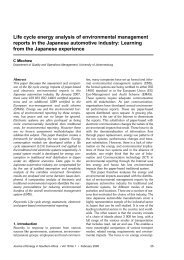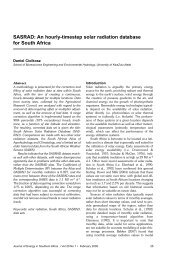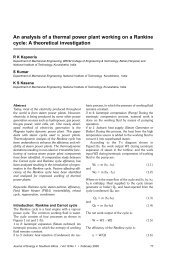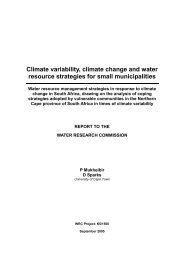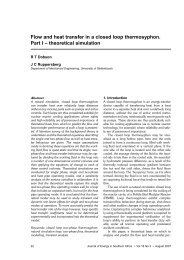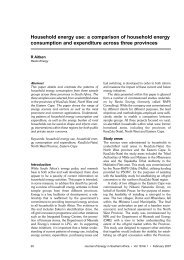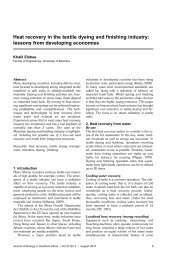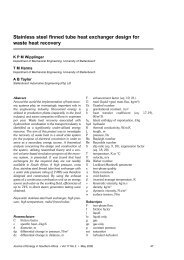Solar electrification by the concession approach in rural Limpopo ...
Solar electrification by the concession approach in rural Limpopo ...
Solar electrification by the concession approach in rural Limpopo ...
You also want an ePaper? Increase the reach of your titles
YUMPU automatically turns print PDFs into web optimized ePapers that Google loves.
<strong>Solar</strong> <strong>electrification</strong> <strong>by</strong> <strong>the</strong> <strong>concession</strong> <strong>approach</strong> <strong>in</strong> <strong>rural</strong> <strong>Limpopo</strong> prov<strong>in</strong>ce: Executive summaryExecutive summaryThe Energy Research Centre (ERC) at <strong>the</strong> University of Cape Town has been <strong>in</strong>volved <strong>in</strong> a researchproject to monitor, evaluate and support <strong>the</strong> off-grid <strong>electrification</strong> programme <strong>in</strong>itiated <strong>by</strong> <strong>the</strong>Department of M<strong>in</strong>erals and Energy <strong>in</strong> 1999 <strong>in</strong> three prov<strong>in</strong>ces of South Africa. The energy servicecompany (ESCO) <strong>approach</strong>, where a company <strong>in</strong>stalls and ma<strong>in</strong>ta<strong>in</strong>s solar home systems for feepay<strong>in</strong>gclients was selected. Private companies were granted exclusive <strong>concession</strong>s to operate as <strong>the</strong>energy service companies <strong>in</strong> <strong>the</strong> selected areas. A government subsidy was provided to reduce <strong>the</strong>connection and service fees payable <strong>by</strong> <strong>the</strong> users.The three <strong>concession</strong> areas are <strong>in</strong> <strong>the</strong> nor<strong>the</strong>ast of KwaZulu Natal prov<strong>in</strong>ce, <strong>the</strong> nor<strong>the</strong>rn part of<strong>Limpopo</strong> prov<strong>in</strong>ce, and <strong>the</strong> nor<strong>the</strong>rn part of Eastern Cape prov<strong>in</strong>ce. ERC has been work<strong>in</strong>g <strong>in</strong> <strong>the</strong>se<strong>concession</strong> areas s<strong>in</strong>ce May 2001, pr<strong>in</strong>cipally through conduct<strong>in</strong>g surveys with <strong>the</strong> aim ofunderstand<strong>in</strong>g <strong>the</strong> social impacts and <strong>the</strong> <strong>in</strong>stallation and function<strong>in</strong>g of <strong>the</strong> solar home systems <strong>in</strong>order to <strong>in</strong>form relevant stakeholders.This report is part of a series on <strong>the</strong> impact of <strong>the</strong> solar home systems. The first report 1 dealt with <strong>the</strong>first survey results from Eastern Cape Prov<strong>in</strong>ce. Follow<strong>in</strong>g <strong>the</strong> above first set of reports, a second setof follow-up reports based on subsequent surveys <strong>in</strong> <strong>the</strong> three prov<strong>in</strong>ces will be prepared. Thesecond set of reports will explore <strong>the</strong> trends over <strong>the</strong> last two to three years follow<strong>in</strong>g <strong>in</strong>stallation of<strong>the</strong> solar home systems. A summary report will conclude <strong>the</strong> series and will compare <strong>the</strong> f<strong>in</strong>d<strong>in</strong>gsfrom <strong>the</strong> three prov<strong>in</strong>ces.The general background to <strong>the</strong> evolution of government policy on provid<strong>in</strong>g universal access toelectricity, and <strong>the</strong> <strong>in</strong>tegration of solar <strong>electrification</strong> is provided <strong>in</strong> <strong>the</strong> first report as well as anumber of papers and articles.The objectives of <strong>the</strong> household surveys.The household surveys aimed to explore <strong>the</strong> impacts of solar home systems over time, ascerta<strong>in</strong><strong>in</strong>g<strong>the</strong> nature and extent of any fuel switch<strong>in</strong>g associated with <strong>the</strong> solar home systems, impacts on <strong>rural</strong>livelihoods, and attitudes of households exposed to solar home systemsA total of 280 households were <strong>in</strong>terviewed <strong>in</strong> <strong>the</strong> survey for this report. 121 of <strong>the</strong> households weresolar home system-electrified, 45 were grid-electrified, and 114 were non-electrified. The gridelectrifiedand non-electrified households were used as control groups. All <strong>the</strong> households are <strong>in</strong>Duvhuledza, Tshamutilikwa, and Mbahe.Characteristics of <strong>the</strong> households surveyed<strong>Solar</strong> home system users were found to be <strong>the</strong> wealthiest; <strong>the</strong> mean monthly <strong>in</strong>come for solar homesystem users was found to be R1543, compared to R1163 for grid users and R819 for non-electrifiedhouseholds. That solar home system users should have <strong>the</strong> highest mean monthly <strong>in</strong>come is notsurpris<strong>in</strong>g because to qualify for <strong>the</strong>se systems <strong>the</strong>y had to have regular <strong>in</strong>come. The mean monthlyper capita <strong>in</strong>come showed a similar pattern, be<strong>in</strong>g highest for <strong>the</strong> solar home system-users. Thehousehold size of solar home system-users was found to be <strong>the</strong> largest, which was unexpected s<strong>in</strong>cewealthier households tend to be smaller. The reason for this may be <strong>the</strong> presence of more relatives at<strong>the</strong>se wealthier households. The trend between <strong>the</strong> o<strong>the</strong>r sub-samples is more conventional, with <strong>the</strong>poorer non-electrified households hav<strong>in</strong>g larger household sizes.Installation of <strong>the</strong> solar home systemsInstallation for solar home systems were found to have been quite prompt, with over 80% ofrespondents gett<strong>in</strong>g <strong>the</strong>ir systems <strong>in</strong>stalled <strong>in</strong> one month or less follow<strong>in</strong>g application. Grid users hadto wait longer, which may be <strong>the</strong> result of <strong>the</strong> more extensive <strong>in</strong>frastructural developments that haveto go with grid extension. <strong>Solar</strong> home system-users were largely satisfied with <strong>in</strong>stallation of <strong>the</strong>irsystems.1ERC. 2004. <strong>Solar</strong> Electrification <strong>by</strong> <strong>the</strong> Concession Approach <strong>in</strong> <strong>the</strong> Rural Eastern Cape: Phase 1. Basel<strong>in</strong>eSurvey.ii





